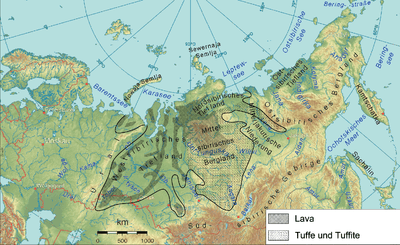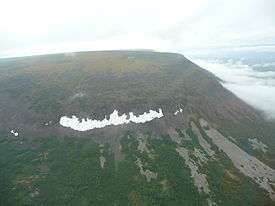Siberian Traps
Coordinates: 67°N 90°E / 67°N 90°E

The Siberian Traps (Russian: Сибирские траппы, Sibirskiye trappy) form a large region of volcanic rock, known as a large igneous province, in Siberia, Russia. The massive eruptive event which formed the traps, one of the largest known volcanic events of the last 500 million years of Earth's geological history, continued for a million years and spanned the Permian–Triassic boundary, about 251 to 250 million years ago.[1][2]
The term "traps" is derived from the Swedish word for stairs (trappa, or sometimes trapp), referring to the step-like hills forming the landscape of the region, which is typical of flood basalts.[3]
Geographical extent
Vast volumes of basaltic lava paved over a large expanse of primeval Siberia in a flood basalt event. Today the area covered is about 2 million km2—roughly equal to western Europe in land area—and estimates of the original coverage are as high as 7 million km2. The original volume of lava is estimated to range from 1 million to 4 million km3.
The area covered lies between 50° and 75° north latitude and 60° to 120° east longitude.
Formation
The source of the Siberian Traps basalt has variously been attributed to a mantle plume which impacted the base of the earth's crust and erupted through the Siberian Craton, or to processes related to plate tectonics.[4] Another possible cause may be the impact that formed the Wilkes Land crater, which may have been contemporaneous and would have been nearly antipodal to the Traps.[5] This controversial scientific debate is ongoing.[6]
The Siberian Traps are considered to have erupted via numerous vents over a period of roughly a million years or more, probably east and south of Norilsk in Siberia. Individual eruptions of basalt lavas could have exceeded 2000 km3.
The presence of extensive tuff and pyroclastic deposits suggests that a number of large explosive eruptions occurred during or before the eruptions of basaltic lavas. The presence of silicic volcanic rocks such as rhyolite is also indicative of explosive eruptions.

Impact on prehistoric life
This massive eruptive event spanned the Permian-Triassic boundary, about 250 million years ago, and is cited as a possible cause of the Permian-Triassic extinction event.[2][7] One of the major questions is whether the Siberian Traps was directly responsible, or if it was itself caused by some other larger event, such as an asteroid impact. A recent hypothesis put forward is that the volcanism was a trigger that led to an explosion of the growth of Methanosarcina, a microbe that then spewed enormous amounts of methane into Earth's atmosphere.[8]
This extinction event, also called the Great Dying, affected all life on Earth, and is estimated to have killed about 90% of all species living at the time.[9] Life on land took at least 30 million years to fully recover from the environmental disruptions which may have been caused by the eruption of the Siberian Traps.[10] Calculations of sea water temperature from δ18O measurements indicate that at its peak, the earth underwent lethally hot global warming, in which equatorial ocean temperatures exceeded 40 °C (about 105 °F).
Paleontological evidence further indicates that the global distribution of tetrapods vanished, with very rare exceptions in the region of Pangaea that is today Utah, between latitudes bounded by approximately 40°S to 30°N. The tetrapod gap of equatorial Pangea coincides with an end-Permian to Middle Triassic global "coal gap" that indicates the loss of peat swamps. Peat formation, a product of high plant productivity, was reestablished only in the Anisian, and even then only in high southern latitudes, although gymnosperm forests appeared earlier (in the Early Spathian), but again only in northern and southern higher latitudes.[7] In equatorial Pangea, the establishment of conifer-dominated forests was not until the end of the Spathian, and the first coals at these latitudes did not appear until the Carnian ~15 million years after their end-Permian disappearance. These signals suggest equatorial temperatures exceeded their thermal tolerance for many marine vertebrates at least during two thermal maxima, whereas terrestrial equatorial temperatures were sufficiently severe to suppress plant and animal abundance during most of the Early Triassic.[1]
Nickel deposits
The giant Norilsk-Talnakh nickel–copper–palladium deposit formed within the magma conduits in the main part of the Siberian Traps.
In popular culture
The Siberian Traps, the eruptive episode that formed them, and the contemporaneous mass extinction have been covered in several documentaries, including Animal Armageddon and The Day The Earth Nearly Died. They have also been mentioned in the 2014 Cosmos: A Spacetime Odyssey in the episode entitled "Some of the Things That Molecules Do", and then even more in depth in the episode entitled "The Lost Worlds of Planet Earth".
See also
References
Notes
- 1 2 Sun, Yadong; Joachimski,Wignall,Yan,Chen,Jiang,Wang,La (October 27, 2013). "Lethally Hot Temperatures During the Early Triassic Greenhouse". Science 338: 366–70. doi:10.1126/science.1224126.
- 1 2 "New Studies of Permian Extinction Shed Light On the Great Dying", New York Times, April 30, 2012. Retrieved on May 2, 2012.
- ↑ Trap at dictionary.reference.com
- ↑ Foulger, G.R. (2010). Plates vs. Plumes: A Geological Controversy. Wiley-Blackwell. ISBN 978-1-4051-6148-0.
- ↑ von Frese, R. R. B.; Potts, L. V.; Wells, S. B.; Leftwich, T. E.; Kim, H. R.; Kim, J. W.; Golynsky, A. V.; Hernandez, O.; Gaya-Piqué, L. R. (2009). "GRACE gravity evidence for an impact basin in Wilkes Land, Antarctica". Geochemistry Geophysics Geosystems 10: Q02014. Bibcode:2009GGG....1002014V. doi:10.1029/2008GC002149. Retrieved 2012-06-20.
- ↑ Czamanske, Gerald K.; Fedorenko, Valeri A. The Demise of the Siberian Plume, January 2004.
- 1 2 "Could Siberian volcanism have caused the Earth's largest extinction event?", Eurekalert!, 9 January 2012. Retrieved on 12 January 2012.
- ↑ "Methane-spewing Microbe Blamed in Earth's Worst Mass Extinction" Scientific American, April 2014, Retrieved on April 7,2014.
- ↑ Benton M J (2005). When Life Nearly Died: The Greatest Mass Extinction of All Time. Thames & Hudson. ISBN 978-0-500-28573-2.
- ↑ Sahney, S. and Benton, M.J. (2008). "Recovery from the most profound mass extinction of all time" (PDF). Proceedings of the Royal Society: Biological 275 (1636): 759–65. doi:10.1098/rspb.2007.1370. PMC 2596898. PMID 18198148.
External links
- "The Siberian Traps" by Richard Cowen
- "The Siberian Traps Large Igneous Province"
- "Toxic Gases Caused World's Worst Mass Extinction"